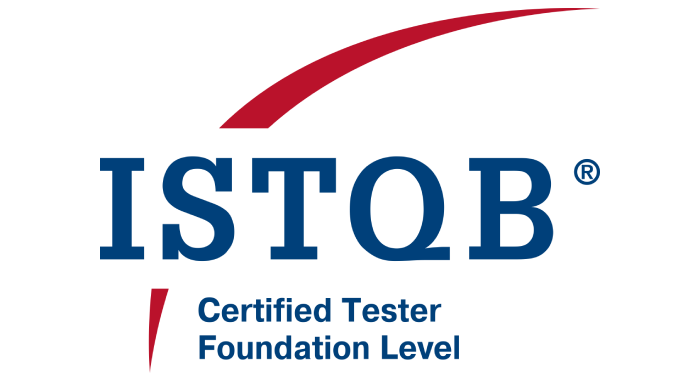Certifications

ISTQB® CTFL
The Foundation Level syllabus forms the basis of the International Software Testing Qualifications Board (ISTQB®) Certified Tester Scheme.
ISTQB® Foundation Level is relevant across software delivery practices
including Waterfall, Agile, DevOps and Continuous Delivery.
The 2018 Foundation Level qualification is suitable for anyone who needs to demonstrate practical knowledge of the fundamental concepts of software
testing including people in roles such as testers, test analysts, test engineers, test consultants, test managers, user acceptance testers and software developers.
It is also vital for individuals who
need a basic understanding of software testing including project managers, quality managers, software development managers, business analysts, IT directors and management consultants.
Issuing Authority: ISTQB - International Software Testing Qualifications Board
Issued Date: Jun 2020

Agile Testing
Learn how to create higher-quality software at a faster clip by implementing agile testing in your organization. Throughout this course, instructor Ash Coleman helps you boost your understanding of the role and methods of software testers, as well as how testing can enhance your agile workflow. To kick things off, Ash goes over the role of the tester in agile teams, detailing how testers govern, monitor, and encourage quality practices. Next, she steps through the agile testing approach and pinpoints where testers can add value. She also helps to acquaint you with key testing processes and responsibilities, including bug tracking; explores both manual testing and test automation; and discusses how continuous integration can be incorporated into the mix.
Course Link: Agile Testing

Agile at Work: Planning with Agile User Stories
gile project teams create short user stories as a way to plan out the work for upcoming sprints. In this course, agile expert Doug Rose shows how to write these user stories and prioritize them in the product backlog. He also shows how to avoid the most common pitfalls with agile project planning.
Course Link: Agile at Work: Planning with Agile User Stories

Scrum: The Basics
Agile project teams create short user stories as a way to plan out the work for upcoming sprints. In this course, agile expert Doug Rose shows how to write these user stories and prioritize them in the product backlog. He also shows how to avoid the most common pitfalls with agile project planning.
Course Link: Scrum: The Basics

Advanced Selenium: 3 Synchronization Strategies
One of the most common issues associated with automating GUI applications is flakiness: when sometimes a test works, but sometimes it fails—even though neither the application nor the test changed. One of the most common causes of intermittent execution is a failure to synchronize effectively. In this course, learn how to avoid flaky tests by effectively synchronizing your test code with the application state using Selenium WebDriver. Instructor Alan Richardson shares fixes to common problems and discusses the range of solutions available to help make WebDriver test automation robust and reliable. Discover how to use built-in WebDriver classes such as WebDriverWait, as well as external libraries like Awaitility. Plus, learn how to use JavascriptExecutor to run JavaScript as part of your WebDriver code; this can help you create workarounds and synchronize against internal application state.
Course Link: Advanced Selenium: 3 Synchronization Strategies

Critical Thinking
One of the most common issues associated with automating GUI applications is flakiness: when sometimes a test works, but sometimes it fails—even though neither the application nor the test changed. One of the most common causes of intermittent execution is a failure to synchronize effectively. In this course, learn how to avoid flaky tests by effectively synchronizing your test code with the application state using Selenium WebDriver. Instructor Alan Richardson shares fixes to common problems and discusses the range of solutions available to help make WebDriver test automation robust and reliable. Discover how to use built-in WebDriver classes such as WebDriverWait, as well as external libraries like Awaitility. Plus, learn how to use JavascriptExecutor to run JavaScript as part of your WebDriver code; this can help you create workarounds and synchronize against internal application state.
Course Link: Critical Thinking

Test Automation Foundations
One of the most common issues associated with automating GUI applications is flakiness: when sometimes a test works, but sometimes it fails—even though neither the application nor the test changed. One of the most common causes of intermittent execution is a failure to synchronize effectively. In this course, learn how to avoid flaky tests by effectively synchronizing your test code with the application state using Selenium WebDriver. Instructor Alan Richardson shares fixes to common problems and discusses the range of solutions available to help make WebDriver test automation robust and reliable. Discover how to use built-in WebDriver classes such as WebDriverWait, as well as external libraries like Awaitility. Plus, learn how to use JavascriptExecutor to run JavaScript as part of your WebDriver code; this can help you create workarounds and synchronize against internal application state.
Course Link: Test Automation Foundations